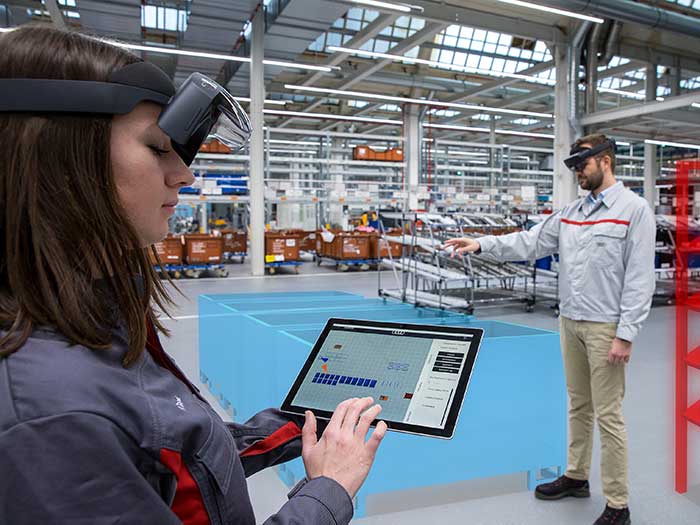Augmented reality and 3D holograms to optimise Audi logistics
Augmented reality is one of the digital tools that represent the future in different areas of production. Audi also uses it to increase efficiency in logistics planning, employing life‑size 3D holograms.
In the transition towards the mobility of the future, exploiting the potential of digital technologies systematically and at all levels is essential. One of the many projects implemented by Audi is the use of augmented reality (AR) to plan complex logistics processes – the virtual presentation of three-dimensional holograms shown in their actual environment helps logistics planners to better evaluate the future situation. Because of this, prototypes of containers or specific equipment, which are elaborate to produce, are no longer necessary.
The LayAR system
Audi uses the new generation of Microsoft’s “HoloLens 2” device for its augmented reality program. The LayAR system (for “layout” and “augmented reality”) helps experts set up new logistics structures in production halls. The software makes use of existing CAD data for various objects, such as shelves, containers, and parts. LayAR visualizes this “digital twin” as a three‑dimensional hologram in the AR device and projects it in life-size form in the actual environment.
Digital Vorsprung
“We use digital technologies systematically in Audi Production where they provide us with true Vorsprung,” says Peter Kössler, Board of Management member for Production and Logistics. AR devices have now become a permanent tool in the logistics planners’ “toolbox.” The devices have made their work faster and more efficient because they allow them to test new components and processes in advance of production or implementation.
Experts in the Ingolstadt body shop are currently planning machine technology for using an innovative driverless transport system, long before the first automated guided vehicles will be delivered.
Supporting production
LayAR will soon also be used for setting up the production of electric vehicles in the main plant. “Up to now, in order to visualize production structures and their relative sizes, we have been using in‑house prototypes of containers, shelves, and lines elaborately affixed to the floor,” says project manager Tobias Brigl.
“This process calls for a great deal of imagination. Augmented reality is an ideal tool to close the gap between the real and the virtual worlds. It helps to recognize problems early on and to develop solutions quickly.”
Sharing and collaboration

AR technology uses synchronization to allow the same images to be shown on multiple AR devices simultaneously. If a user reaches for an object, they can move it, turn it, or replace it with simple movements of their hands. All involved can see changes in real time.
The shared image simplifies discussion and thus facilitates working together – even beyond the boundaries of sites and national borders. In the future, specialists from other plants or those working from home can be included in the decision‑making process.
From the virtual to the real
A Supply Chain Planning project team tested the new software together with development partner Viscopic for a number of months, using it during planning workshops in the production hall, during presentations, and in layout discussions in the office.
LayAR makes it possible for planners to virtually miniaturize the entire setup of the hall to the point where it can be projected onto a desk. A virtual tool then facilitates the precise measurement of distances and areas directly within the holographic image. All changes and results can then be transferred into the CAD data in as little as a couple of seconds. This means that all participating employees can continue to work using the new, updated planning status.
Other applications
Audi is also using mixed reality in other areas. For example, Audi Product Communications has already been using “virtual exhibits” for several years to help journalists visualize technical processes and complex technologies. The holographic animations are based on CAD design data and are presented in 3D using second-generation HoloLens devices as well during press events.
Source: Volkswagen AG
